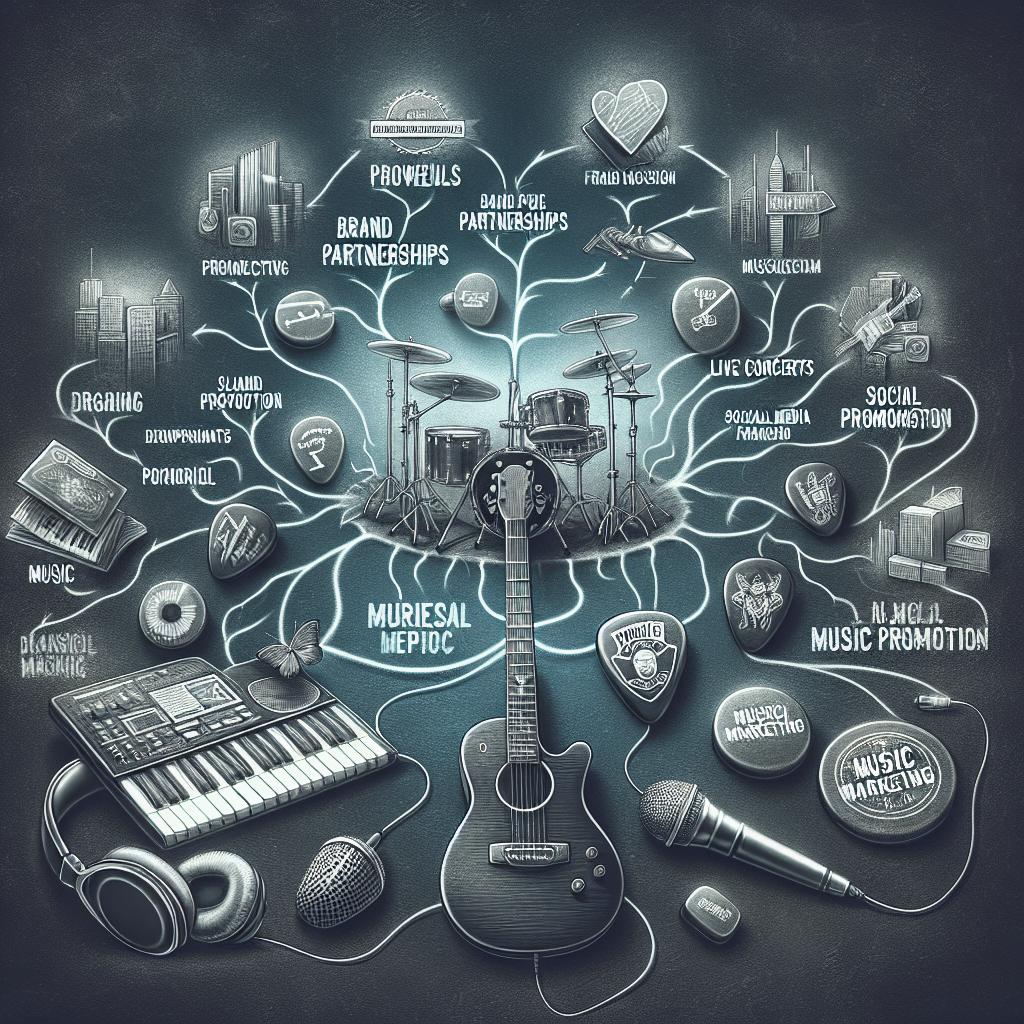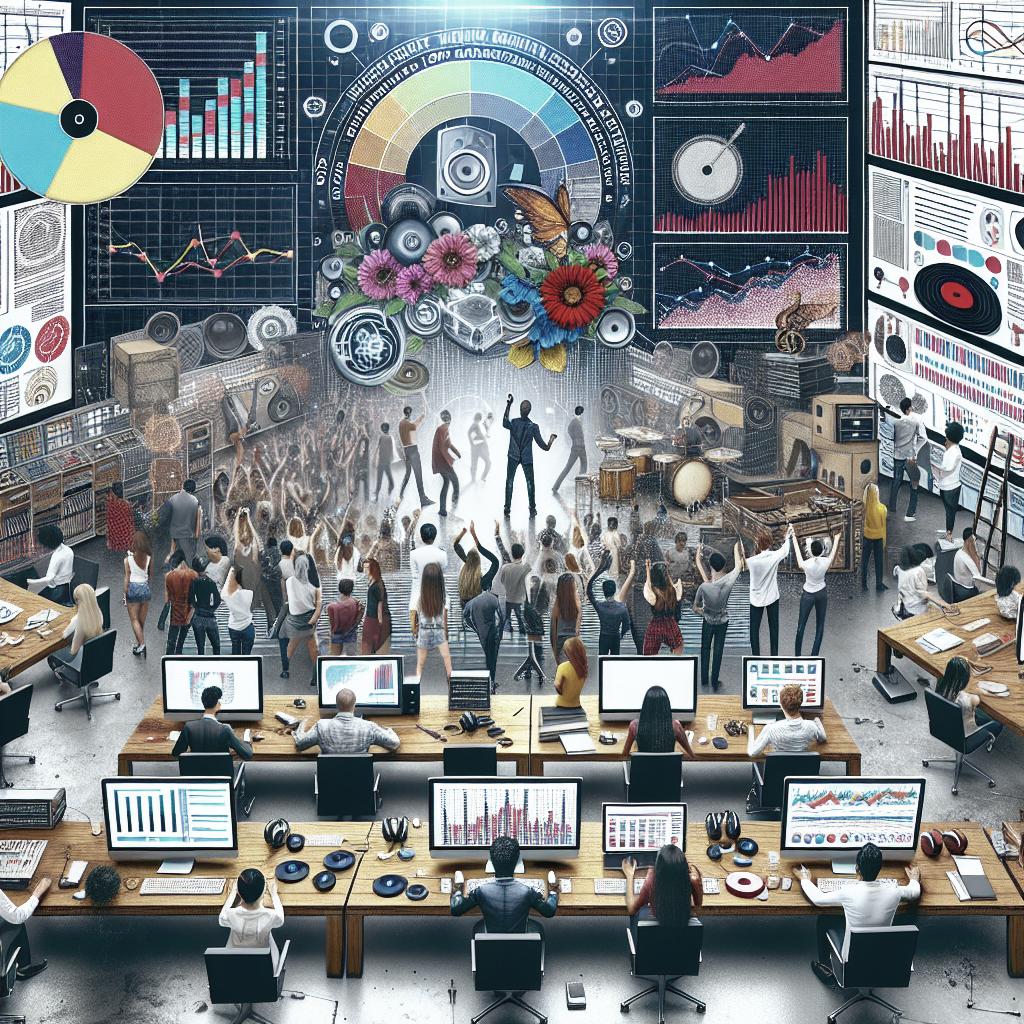Music marketing is an essential part of any artist’s journey to success. It’s not just about creating great music, but also about getting it heard by the right people. With the advent of digital platforms and social media, the avenues for reaching a broader audience are more accessible than ever before. This blog post explores powerful marketing strategies for music artists, touching on vital aspects such as building a fanbase on social media, playing live, creating stunning visual content, and networking with industry professionals. It further discusses more nuanced strategies like creating press kits, newsletters, and using targeted ads. Additionally, you’ll find information on getting your music on Spotify playlists, collaborating with other artists, and utilizing various music marketing platforms. Let’s dive into these powerful tools that can propel your music career to the next level. —
1. What is music marketing
Music marketing involves the promotion and selling of music through various channels to reach a broader audience effectively. It encompasses strategies like social media promotions, live performances, press releases, and collaborations. Essentially, it’s about creating visibility and engagement for your music, turning listeners into fans, and leveraging different platforms to increase your reach. In today’s digital age, music marketing has evolved dramatically. Gone are the days when artists solely relied on radio plays or physical album sales. Now, streaming platforms, social media, and digital advertising play a crucial role in shaping an artist’s career. Comprehensive music marketing strategies can significantly impact an artist’s success. —
2. Build a fanbase on social media
Social media is a powerhouse for music marketing. Platforms like Instagram, Twitter, TikTok, and Facebook offer direct access to millions of potential fans. To build a fanbase, artists should post regularly, engage with their audience through comments and direct messages, and utilize features like Instagram Stories or TikTok’s short videos for behind-the-scenes content. Leveraging social media analytics tools to understand the demographics and behaviors of your audience can refine your strategies. Identify which content resonates most and adjust your plans accordingly. Remember, consistency and authenticity are key to nurturing a loyal fanbase. —
3. Play live
Live performances are crucial for building a genuine connection with your audience. Whether you’re performing at local venues, music festivals, or virtual concerts, they offer a chance for people to experience your energy and talent firsthand. It’s also an opportunity to sell merchandise and network with fans and industry professionals. Playing live also helps in building your reputation and gaining exposure. Live-streaming performances on platforms like Instagram Live or Facebook Live can reach fans who can’t attend events in person, further expanding your audience. —
4. Create stunning visual content to market your music
In the visually-driven world of social media, high-quality visual content can significantly boost your marketing efforts. This includes music videos, album covers, promotional photos, and creative graphics. Visually appealing content grabs attention and can make your music more memorable. Partnering with skilled photographers, graphic designers, and videographers can elevate your visual content. Invest time in creating a cohesive visual aesthetic that aligns with your brand and music style. This visual consistency helps in creating a strong, recognizable identity for your music. —
5. Create a press kit
A press kit is a comprehensive package of information about you and your music, designed for media outlets and industry professionals. It typically includes a bio, high-resolution photos, music samples, press releases, and contact information. A well-crafted press kit makes it easier for journalists, bloggers, and promoters to feature your music. Ensure your press kit is professional and up-to-date. Investing time in a quality press kit can lead to more media coverage, interviews, and performance opportunities, significantly enhancing your visibility in the industry. —
6. Network with industry professionals
Building relationships within the music industry is vital for your career’s growth. Attend industry events, music conferences, and networking functions where you can meet producers, managers, promoters, and other artists. These connections can open doors to new opportunities, collaborations, and valuable advice. Networking isn’t just about what others can do for you; it’s also about what you can offer. Be genuine, supportive, and maintain strong professional relationships. Positive connections can create a supportive network that will help promote and advance your music career. —
7. Create a newsletter for your fans
Newsletters are an effective way to keep your fans informed and engaged. Through email marketing, you can share exclusive content, upcoming shows, new releases, and personal messages directly with your audience. This creates a more intimate connection and keeps your fans invested in your journey. Platforms like Mailchimp or Substack make creating and managing newsletters straightforward. Regular updates ensure that your fans feel included and valued, which translates into long-term support and enthusiasm towards your music. —
8. Use targeted ads
Digital advertising provides precision targeting to reach potential fans who are most likely interested in your music. Platforms like Facebook, Instagram, and Google Ads offer tools to target audiences based on demographics, interests, and behaviors. Using these tools effectively can lead to increased streaming numbers, social media followers, and overall brand awareness. Creating compelling ad content with clear calls to action is crucial for the success of your targeted ad campaigns. Monitor ad performance regularly and adjust strategies to optimize results, ensuring maximum return on investment. —
9. Post cover songs to social media and YouTube
Posting cover songs can attract new listeners, especially if you cover popular tracks. These covers can act as gateways to your original music. Social media and YouTube are excellent platforms for sharing these covers, providing opportunities for virality and expanded reach. Ensure high-quality audio and video production for your covers to create a professional impression. Creativity and originality in your interpretation of the songs can make your covers stand out and attract a wider audience. —
10. Get your music into Spotify playlists
Spotify playlists can significantly increase your music’s exposure. Playlists curated by Spotify’s editorial team or popular influencers have thousands, sometimes millions, of followers. Getting featured on these playlists can lead to increased streaming numbers and new fans. Submit your music to Spotify’s editorial team and consider using services that connect your music to independent curators. Regularly release new music to sustain interest and improve your chances of being picked for playlists. —
11. Collaborate with other artists
Collaborating with other artists can introduce your music to new audiences. Cross-promotions through collaborations help you tap into the fanbases of your collaborators, leading to mutual growth. Collaborative projects can include joint singles, remixes, or live performances. Choose collaborators who complement your music style and share your audience demographic. Successful collaborations should be mutually beneficial, providing creative synergy and promotional advantages for all parties involved. —
12. Use the best music marketing platforms
Several platforms specialize in music marketing, offering tools and resources to amplify your promotional efforts. Platforms like ReverbNation, Bandcamp, and SoundCloud Pro provide comprehensive marketing services, including fan engagement tools, distribution options, and analytics. These platforms help streamline your marketing strategies and offer insights into audience engagement and music performance metrics. Utilizing these platforms effectively can enhance your visibility, reach, and interactive engagement with your fanbase. —
Next steps
“`html
| Strategy | Description | Benefit |
|---|---|---|
| Build a fanbase on social media | Utilize platforms like Instagram, Twitter, and Facebook to engage with fans. | Direct access to millions of potential fans and consistent interaction. |
| Play live | Perform at local venues, festivals, and live-stream concerts. | Build genuine connections and gain exposure. |
| Create stunning visual content | Produce high-quality music videos, album covers, and photos. | Enhance visibility and create a memorable brand identity. |
| Create a press kit | Compile a professional kit with bio, photos, music samples, and press releases. | Facilitates media coverage and industry recognition. |
| Network with industry professionals | Attend events and build relationships within the music industry. | Open doors to new opportunities and collaborations. |
| Create a newsletter | Send regular updates and exclusive content via email. | Foster a loyal fanbase and keep fans engaged. |
| Use targeted ads | Utilize digital advertising to reach specific audience segments. | Increased streaming numbers and enhanced brand awareness. |
| Post cover songs | Share covers of popular songs on social media and YouTube. | Attract new listeners and broaden your audience. |
| Get into Spotify playlists | Submit music for playlist consideration and use services to connect with curators. | Increased streaming numbers and new fans. |
| Collaborate with other artists | Engage in joint projects like singles, remixes, or performances. | Mutual growth and access to new fanbases. |
| Use marketing platforms | Leverage platforms like ReverbNation and Bandcamp for promotion. | Streamline marketing efforts and enhance audience engagement. |
“`


